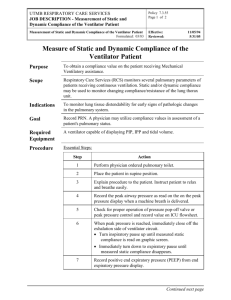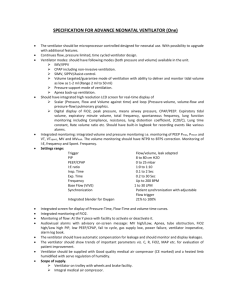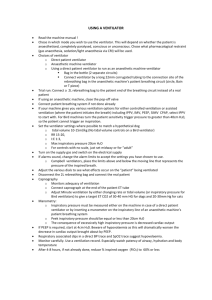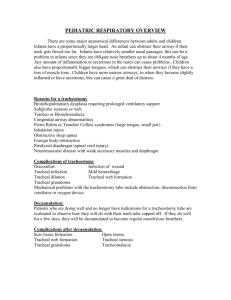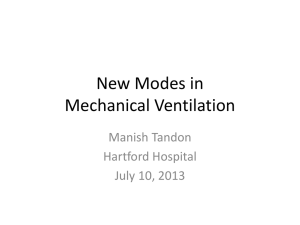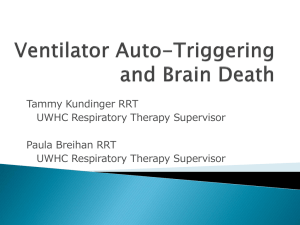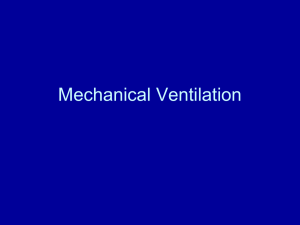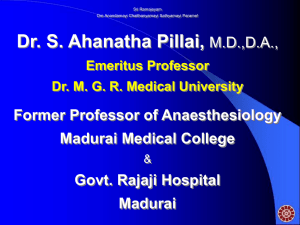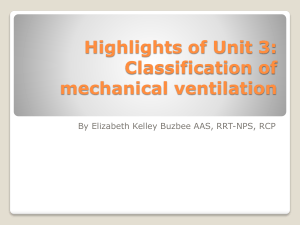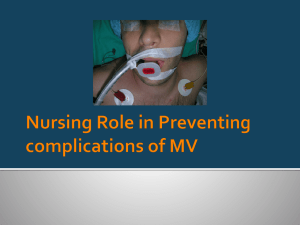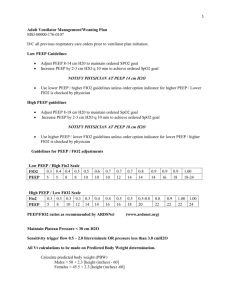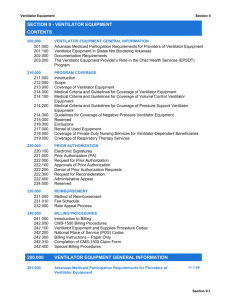LTV Ventilator Training
advertisement
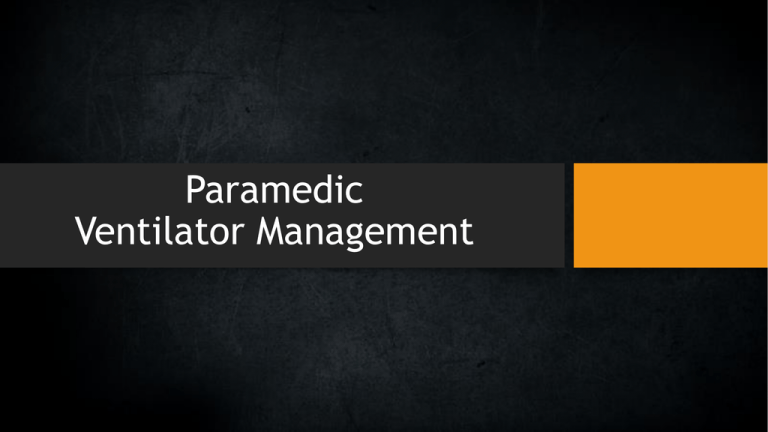
Paramedic Ventilator Management Ventilator Training Goals • • • • • Determine the type of injury. Familiarize with MLREMS Protocol. Familiarize with LTV 1000/1200 Familiarize with AutoVent 3000 DOPE and trouble shooting What type of respiratory problem? • Crashing Patient • Medical 500 • Respiratory Arrest • Lung Injury • ARDS (adult respiratory disease syndrome) • Obstructive • Asthma • COPD What type of respiratory problem? Crashing Patient • Use • Once you have ROSC • Enroute to hospital with crashing patient What type of respiratory problem? Lung Injury patients • Injured lungs are baby lungs • Delicate • Less lung for tidal volume and gas exchange • ARDS is injury to lung tissue often from sepsis • 5 of PEEP to start is good. • PEEP DOES NOT POP LUNGS What type of respiratory problem? Obstructive Patients • • • • Obstructive Patients are your Asthma and COPD patients. Air is trapped in their alveoli Slower rates Lower PEEP is ok remember obstructive patients auto PEEP MLREMS Ventilator Protocol 2.32 In Accordance with Policy 9.19 • A patient who requires manual ventilation in the pre-hospital environment who has received emergent endotracheal • intubation or who has a pre-existing tracheostomy tube and meets the following criteria: At least 10 minutes of patient contact expected Weight ≥ 40 kg Systolic blood pressure ≥ 90 Able to ventilate without difficulty MLREMS Ventilator Protocol 2.32 In Accordance with Policy 9.19 (Cont.) • Paramedics Must Provide on a ventilator patient • • • • Standard Medical Care SpO2 ECG ETCO2 with Continuous Waveform MLREMS Ventilator Protocol 2.32 In Accordance with Policy 9.19 (Cont.) • Field Calls • Start with BVM ventilations while you confirm ventilator and hemodynamic stability • BVM with oxygen @ 100% for at least 2 minutes prior to ventilator. • Set Ventilator (if available)on Assist Control • • • • Rate (f) 10-12 FiO2 1.0 (100%) Tidal Volume (Vt) 5-6ml/kg Preferred body weight. PBW = (2.3 x Height (in) – 60) + 45 for women and 50 for men. • Example: 72 inch tall male • [2.3 x (72-60)] + 50 = 77.6 kg for a preferred body weight. • 77.6 kg x 6 ml = 465.6 or 465 cc Vt. MLREMS Ventilator Protocol 2.32 In Accordance with Policy 9.19 (Cont.) • Lets try one more Tidal Volume Calculation! • • • • • • • 48 year old female 66 inches tall PBW = (2.3 x Height (in) – 60) + 45 for women and 50 for men. Tidal Volume (Vt) 5-6ml/kg Preferred body weight. Set Ventilator (if available)on Assist Control. (2.3 x 66 – 60) + 45 = 58.8 lets say 59 for ease so the pt’s PBW is 59kg. 59kg x 6ml = 354ml So the Vt is 355 for this patient MLREMS Ventilator Protocol 2.32 In Accordance with Policy 9.19 (Cont.) • Field Calls (Cont.) • Adjust Vent settings to achieve • SpO2 of > 96% • EtCO2 38-42 • Peep at 5 cm H2O May adjust up to 10 Failing Ventilation • If patient becomes hypoxic, hypercarbic, or has increased work of breathing, discontinue the ventilator and perform BVM ventilations per Airway Management Protocol (2.0 or 2.1). Evaluating Ventilator Problems with DOPE • Dislodged (low pressure) • Moved from airway • Circuit fell off • Obstructed (High pressure) • Kink in circuit • Suction Required Evaluating Ventilator Problems with DOPE • Pneumothorax (High Pressure) • Unequal lung sounds • Vitals change • Equipment failure • Loss of power • Circuit failure • Loss of oxygen Call for help! • Remember that first and foremost the welfare of the patient is priority number one. • Formulate a plan • Call medical control Stable Outpatient • MLREMS Defined as: • “A patient on a ventilator in an outpatient setting with no acute cardiac or respiratory complaints who is requesting ambulance transport” • These are primarily trach patients. Outpatient are usually not intubated. Stable Outpatient • Provide • ECG • SpO2 • EtCO2 with Waveform • If a RTT is accompanying the patient, that provier will manage the vent. • With no RTT the Paramedic will utilize the patients exiting settings on their current or transport ventilator. • Paramedic may increase FiO2 if required by the patient Stable Outpatient • If the patient becomes Hypoxic, Hypercarbic or has increased work of breathing and there is no RT: • Discontinue Ventilator • Perform BVM ventilations per airway management protocol (2.0 or 2.1) • Every time you move a patient check the ETT and listen to lung sounds. • Again Visit DOPE: • • • • Dislodged Obstruction Pneumothorax Equipment failure AutoVent 3000 LTV 1200 LTV Controls Settings for LTV 1200 • • • • • • Rate (f) Tidal Volume (Vt) FiO2 Mode PEEP Power Transducing and Monitoring • Vent Circuit Attachment • Transducing lines are attached with: • White • Yellow • Slide on Tube The Auto Vent 3000 AutoVent 3000 • BPM is your Rate (f) • Setting for respiratory time • Adult • Child • Tidal Volume (Vt) AutoVent 3000 • Quick connection to oxygen supply. • Removable for high pressure fitting. AutoVent 3000 • Easy connection regulator Review Provide Standard Care EKG/EtCO2/SpO2 Do the math for the Vt BVM before Vent Check your settings Every time you move check the tube and check lung sounds. DOPE For more information see: http://specmed.org/2013/04/02/ventilator-management-in-the-transportenvironment/ Resources • http://www.specmed.org • http://www.mlrems.org

